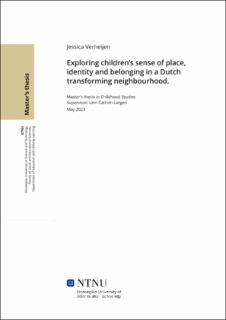| dc.description.abstract | This research aims to explore children’s experiences in a transforming neighbourhood in a Dutch context. Within this aim, the research focused more specifically on children’s sense of place, belonging and identity in relation to their neighbourhood experiences. In the Netherlands, many neighborhoods are undergoing gentrification with the aim of improving the safety, wellbeing, and social cohesion of residents. Despite the growing emphasis on community participation and inclusion, policy documents often do not incorporate children’s voices within neighbourhood reports. This research aims to bridge the gap between the lack of children’s participation within policy documents and their experiences within the transforming neighbourhood. By shedding light on children’s experiences, a clearer picture can be sketched of experiences within a Dutch neighbourhood that can be taken into consideration for future policies. To explore the aim of this research, a qualitative research approach was utilized. This study is positioned within the field of childhood studies, which perceives children as social actors in their own lives and those around them. To facilitate the inclusion of children’s voices in the study, participatory methods such as photography walks and drawings were used in addition to semi-structured interviews. Additionally, the perspectives of stakeholders were included as children’s agency within the neighbourhood is dependent on the relations with those around them.
The analysis reveals that children attach value to places within the neighbourhood that offer safety and supervision and tend to stay away from areas where they don’t feel comfortable due to interaction with certain groups of people. Children feel a sense of place in the neighbourhood that have been created by adults but also create their own places to attach meaning to. Even though the places and experiences that children describe differ from each other, the value they find within these places are similar to one another. The diverse experiences related towards places in the neighbourhood further revealed a gap in the feeling of belonging of older and younger children in the neighbourhood. Additionally, the study found that children’s neighbourhood experiences are related to their own understanding of age-appropriate activities which are argued to be influenced by the cultural norms around them. The findings suggest that children’s values within the neighbourhood align with the same values that the stakeholders shared to be the aims of neighbourhood organizations. Within these shared perspectives of stakeholders and children, the global north childhood seems to be reproduced within the gentrification processes in the neighbourhood. | |
